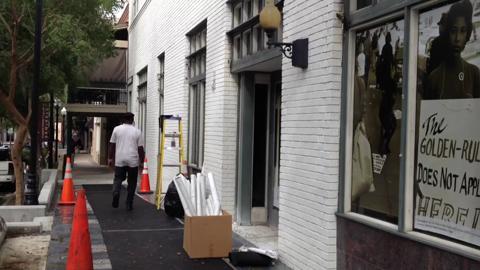City Will Unveil Heritage Trail Honoring 58 People Today

A slice of Tallahassee’s turbulent yet triumphant past is captured in a permanent display near the corner of Jefferson and South Monroe streets.
There, in 1956, frustrated Florida A&M students marched and hoisted protest signs demanding equal rights while riding the city bus. Through lunch counter sit-ins in the 1960s, protestors declared impartial service was a basic human right, not a privilege bestowed only for whites.
Today, their bold call for justice will be honored by city and county officials in an hour-long “Footsteps to Freedom” program that will unveil the Tallahassee-Leon County Civil Rights Heritage Walk — a unique sidewalk segment paying tribute to 58 men and women, both black and white, who played a part in the two protests.
“Justice was not being done, and we were very interested in seeing justice for everybody,” said Tallahassee honoree Eddie Barrington, 93, who drove carpools for blacks during the boycott. “I think we made a difference in Tallahassee.”
What commenced on that sidewalk, lined by retails stores such as the former McCory’s five-and-dime store, was the nation’s second major bus boycott just months after the historic bus boycott in Montgomery, Ala.
Protestors were arrested. The Inter-Civic Council, the first local protest organization representing a cross-section of Tallahassee’s black community, galvanized. Civil rights leaders like the Rev. C.K. Steele, the ICC’s president and pastor at Bethel Missionary Baptist Church on West Tennessee Street, led local efforts that mirrored work mobilized by the Rev. Martin Luther King Jr.
Steele, then age 42, had been in Tallahassee four years when he was thrust into a leadership position in the bus boycott, according to “The Pain and the Promise: The Struggle for Civil Rights in Tallahassee.”
Like him, many stood up and their names are etched in brass footsteps bordering Heritage Walk. Those “foot soldiers” include R.L. Anderson, the Rev. James L. Hudson, George Lewis, James Mobley and Sybil Mobley, among others. The actions of Wilhelmenia Jakes and Carrie Patterson, two FAMU students, prompted Tallahassee’s bus boycott with their refusal to exit a city a bus after a bus driver saw them sitting next to a white woman, according to the “Pain and the Promise.”
Others, like Barrington, an ICC member, drove black residents to work. Tella-Marie Norwood Williams, of Oakland, Calif., will join her brother and sister today as her grandmother, Willie Kershaw Perkins, and her father, Edwin F. Norwood Sr., are recognized for bailing protestors out of jail.
On Saturday, Williams and her sister, Barbara Norwood Noble, were among a handful of living foot soldiers and their descendents gathered for a meet-and-greet at the Riley House and Museum’s new visitor center on Jefferson Street. Full of emotion, she said the city’s tribute is fitting.
“It means the Kershaw-Norwood love and sacrifice will be permanently displayed for others to see and learn more about,” she said. That alone touches her heart.
The $65,000 project, paid for by the joint Community Redevelopment Agency, includes 16 pieces that make up six panels created by Florida State University’s Master Craftsman Studio on Gaines Street. Three panels are dedicated to the sit-ins and another three are aimed at the bus boycott.
“I think, not only is it a great piece of public art, it’s integrated into the sidewalk and so it’s a part of the city now,“ said Phil Gleason, the studio’s production manager. “I think that people will have a sense of amazement, and others will take it all in.”
The panels, concrete with terrazzo tops weighing 440 to 2,200 pounds each, took three months to complete. They were actually supposed to be dedicated in October 2011 but were delayed due to the demolition of the old McCrory’s site.
The commemorative sidewalk idea sparked following a July 2009 public hearing where residents expressed something be done to remember some of Tallahassee’s historic protests, said Dan Donovan, senior urban planner for the Tallahassee-Leon County Planning Department, who designed the memorial sidewalk.
After watching, Donovan began drafting a mock up of what could take root as a fitting memorial. His boss and department director, Wayne Tedder, gave the green light.
“It’s not just my project,” he said, regarding what’s his favorite part of the tribute. “It’s the project of dozens of staffers working to get the sidewalk dedicated and in place.”
Last week, with the permission of current businesses, city staffers lined windows facing Jefferson Street with vinyl vintage black-and-white images of protestors, McCrory’s owners and window displays of merchandise sold at the store. Passersby couldn’t help but slow their strolls and take a look. A long black tarp over the sidewalk concealed the true treasure, with the exception of a few brass footsteps peeking out.
Tallahassee black history expert Altemese Barnes, Riley Museum’s director, believes the tribute may be the first of its kind in that it incorporates the names of history makers in footsteps since they were “foot soldiers” for justice. She envisions teachers bringing curious young people to study the names, which ensures Tallahassee’s history is learned by future generations.
“This has an explosive kind of development that can take place,” she said. Barnes went on to say of the protests, “It took a lot of different people and they didn’t all look like us.”
Meaning, several white people took a risk by joining the movement.
Jane Lee Wilson, 71, of Arcata, Calif., remembers stories told by her father, James Shaw, owner of the former Shaw’s Furniture Company on College Avenue. Shaw, and his wife, Lillian, will be memorialized in the Heritage Walk’s golden footsteps for bailing students out of jail.
As a preteen, Shaw saw a black person lynched in his hometown of Quincy, Wilson recalled. He never wanted to see that happen again or any injustice.
“He was never a bigot, even though he was surrounded by bigots,” said Wilson, who won’t be attending today’s program. “My father really wanted to do the right thing. That was his guiding light. He was totally for civil rights.”
Wilson’s parents will be represented at today’s program by Louise Bennett and Williard Jefferson, the children of Harrietta Jefferson, who worked as the family’s maid but was more like a mother to Wilson. Jefferson’s daughters were like her sisters.
A few weeks ago, she was alerted by the city her parents would be honored. She’s always been proud of her parents, but today, she’s proud of Tallahassee for honoring those who became pioneers on the side of good.
“I’m proud things have changed,” she said. “We don’t ever want to go back to what I grew up in.”
Source: http://www.tallahassee.com/apps/pbcs.dll/article?AID=2013309300012&nclick_check=1











